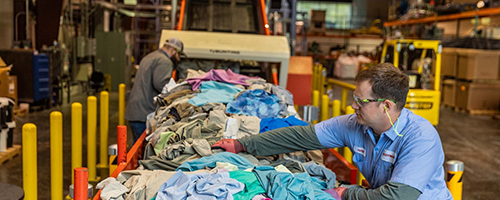|
|
|
|
|
|
|
|
|
|
|
|
Investors Are Funding Ways to Adapt to Climate Change
|
|
|
|
|
|
|
|
Today: Investors are trying to find new ways to adapt to extreme climate; the Energy Department sourced climate skeptics to justify its climate rollback; Ford gets hit by Trump’s ‘America First’ tariff policy.
|
|
|
|
|
|

|
|
Volunteer Bryan Bailey works to clear fallen trees in Hunt, Texas. PHOTO: (Brandon Bell/Getty Images)
|
|
|
|
|
|
Welcome back: On a muggy July morning, the day after a thunderstorm hammered parts of Washington D.C., a tiny triangular patch of land built to drain stormwater had done its job. The designers had adapted the landscape to manage rushing rainwater, soaking up the excess like a sponge, WSJ Pro Sustainable Business reports.
The drainage project, near the sprawling Rock Creek Park, is part of a growing category of finance focused on risk adaptation, aimed at dealing with the impacts of extreme weather such as heavy rainfall, drought, wildfire and heat waves happening in greater frequency and intensity.
French investment bank BNP Paribas estimates the climate-adaptation market could be worth some $2 trillion by 2026. It’s becoming increasingly sought after, not just in D.C. but in locations across the U.S. hit by more frequent bouts of extreme weather.
For those pushing the new investment area, protecting existing infrastructure is key. Sierra Club, a U.S.-based environmental group, estimates the global economy could face annual losses exceeding $38 trillion by midcentury because of the effects of climate change.
|
|
|
|
|
|
|
|
|
Content from our sponsor: Deloitte
|

|
|
Eastman CTO: Using Sustainability Trends, Innovation to Disrupt Markets
|
|
Chris Killian, Eastman’s chief technology and sustainability officer, discusses how technological innovation focused on circularity can be a strategic lever for revenue growth and competitive advantage. Read More
|
|
|
|
|
|
|
|
|
Climate Skeptics Are Tapped by Trump Administration to Justify Regulatory Rollback
|
|
|
|

|
|
Environmental Protection Agency director Lee Zeldin PHOTO: (Julia Demaree Nikhinson/Associated Press)
|
|
|
|
|
|
To make its case that climate regulations should be tossed out, the Trump administration asked a group of five researchers who are skeptical of established climate science to write a report for the Energy Department, Eric Niiler and Scott Patterson write for the WSJ.
The report challenges decades of scientific findings that emissions from cars, power plants and factories are warming the planet and posing risks to human health. The Environmental Protection Agency is using the report as the scientific basis to roll back its so-called endangerment finding, a legal tool that allows the agency to regulate industries and automakers under the Clean Air Act.
Steven Koonin, a fellow at Stanford University’s Hoover Institution and a theoretical physicist who contributed to the report argued that increasing carbon dioxide is good for plant growth, that temperatures in the U.S. are milder now than in the 1930s, that heat waves, floods, wildfires and other extreme weather aren’t getting worse, and that current computer models are inaccurate and can’t predict future atmospheric warming.
|
|
|
|
|
“The science does not say what you think it says”
|
|
— Steven Koonin, a fellow at Stanford University’s Hoover Institution and a theoretical physicist who contributed to the report for the Energy Department.
|
|
|
|
|
|
|
|
Why Ford’s Made-In-America Strategy Hurts It in Trump's Trade War
|
|
|
|

|
|
A vehicle assembly technician works on a 2025 Ford Expedition PHOTO: (Carolyn Kaster/Associated Press)
|
|
|
|
|
|
There is an irony in Detroit right now: The automaker most reliant on U.S. manufacturing is among the hardest hit by tariffs.
Ford Motor, the second-largest American carmaker, prides itself on making most of its vehicles in the U.S. Some 80% of the cars Ford sells in the U.S. are built there, and it makes more vehicles in the U.S. than any other automaker, the WSJ’s Sharon Terlep reports.
But the Dearborn, Mich., company said the Trump administration’s latest trade deals with Japan, the European Union and South Korea put it at a disadvantage with foreign rivals. Those deals now set a 15% tariff rate, which is lower than the 25% auto tariff that went into effect this spring.
Ford faces steeper tariffs on many parts as well as higher costs for imported aluminum, which is subject to 50% duties. Ford, one of the industry’s biggest users of aluminum, buys the material from U.S. suppliers who pass on a chunk of their tariff costs.
See also: Here’s How Companies Are Dealing With $50 Billion of New Tariffs
|
|
|
|
|
|
|
|
|
|
|
|
-
What’s ahead for food (WSJ)
-
Trump wants a new border wall. It would block a key wildlife corridor. (NYT)
-
New Zealand government votes to bring back fossil fuel exploration in major reversal (Guardian)
-
Gov. Newsom seeks to raise $18 billion to shore up state wildfire fund (LA Times)
-
In a country Trump says nobody’s heard of, tariffs bring chaos (WSJ)
|
|
|
|
|
|
|
|
|
|
|
|
|
|
|
|